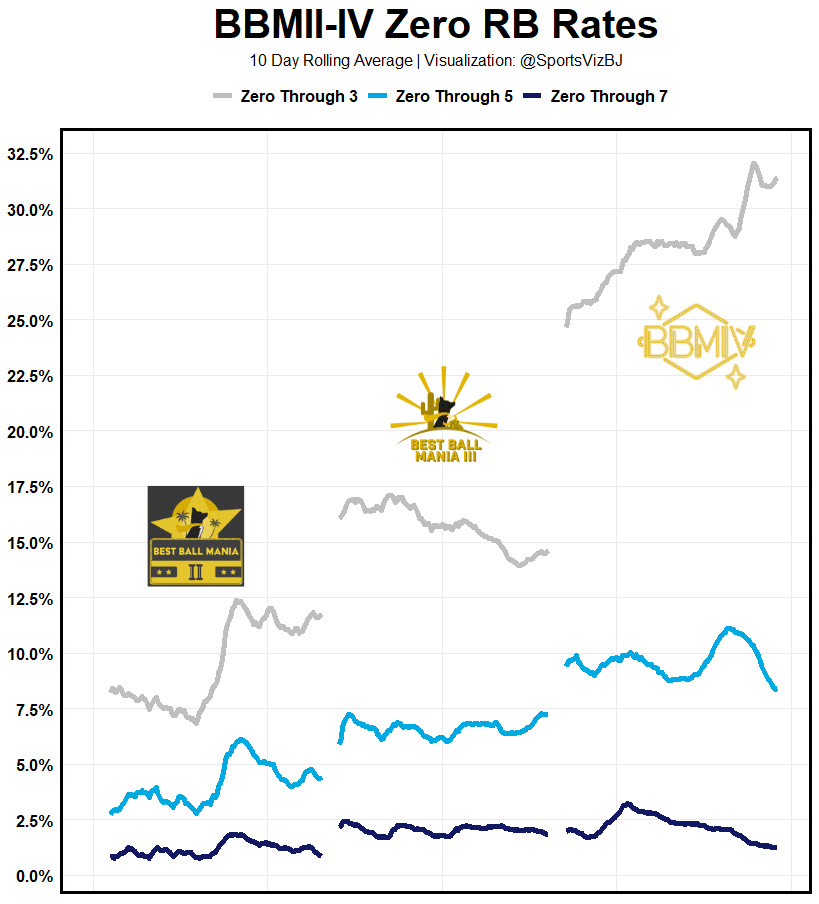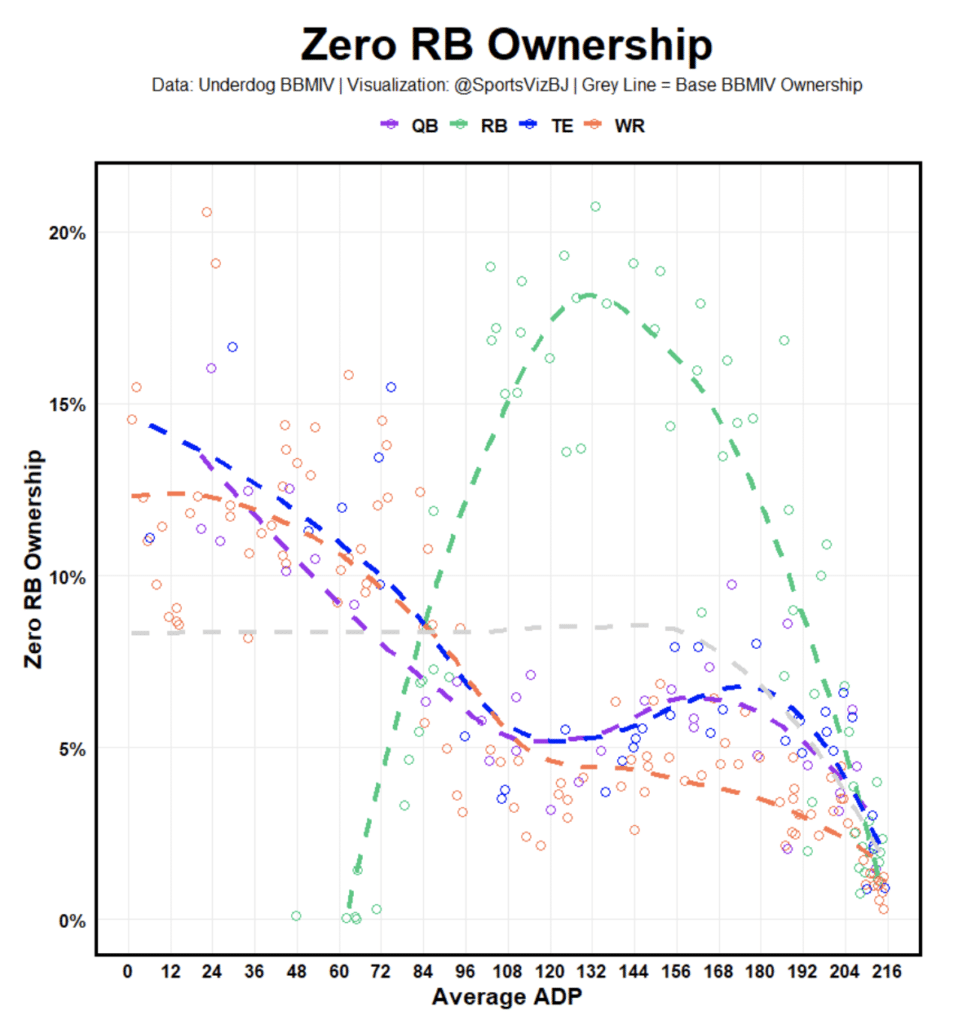Welcome to the very first installment of a new foundational series on Spike Week called The Formula. The Formula is a series of data driven studies intended to give you an edge in your Best Ball drafts. We’ll be bringing you installments in The Formula on every angle of Best Ball strategy, from roster construction, to player selection, to draft capital allotment, and anything else you can imagine, including analysis on NFL, MLB, NBA or any Best Ball sport.
Naturally, we’ll be starting with the NFL, and I couldn’t think of a better subject to dive into first than Zero RB with the Spike Week community. But not only is this installment going to dive into the utilization of Zero RB, but it led to some more eye brow raising insights around player selection within roster constructions.
Let’s dive in.
Zero RB & Structural Player Selection Biases
Defining Zero RB
Let’s start with a common understanding: Zero RB is a draft strategy that prioritizes elite wide receivers, tight ends, and quarterbacks early on, deferring the selection of running backs until later rounds. The rationale? Running backs face higher injury risks, and their production, beyond the elite tier, is often replaceable. By loading up on top-tier options elsewhere, a drafter can build a formidable team, relying on a volume-based approach to secure serviceable running back production. Zero RB also allows for a significant upside when a cheap bet hits. While there is an expectation that some (or most) of these bets will fail, the strategy acknowledges that the hits on those cheap bets greatly outweigh the misses. For our analysis, Zero RB entails selecting zero running backs through the first seven rounds, opting instead for a combination of elite wide receivers and quarterbacks.
Zero RB Trends BBMII-IV
The way people are drafting the running back position has shifted massively over the last few years.
The Zero RB craze ignited during BBMII, not long after the Ship Chasing crew and our very own Erik Beimfohr discussed why Zero RB could offer a significant edge in the tournament. (https://www.youtube.com/watch?v=Bn3Wi4eWsH4 & https://www.youtube.com/watch?v=LSpijP9IpLU).

By the time BBMIII opened, the field clearly had gotten a little more comfortable with the concept of zero RB as positional scarcity had become a big talking point in the community. The 10-day rolling average of Zero RB increased from 1-2% in BBMII to between 2-2.5% for the entirety of BBMIII.
BBMIV witnessed a surge in prices for wide receivers and quarterbacks, directly impacting early running back drafting rates. As such we saw a rise in zero running backs through the first three rounds during the entire drafting window, which was interestingly paired with a decrease in zero running backs through the first seven rounds, outside of the early summer drafting window which is filled with us sickos.
Despite the prevalence of drafters entering the tournament in a high-volume fashion (defined as 100-150 entries – fun fact – of the 677,376 entries, 216,137 (31.9%) were from someone who had 100 or more entries), the data did not indicate a surge in the Zero RB strategy. This shocks me as I would have expected these high-volume drafters to be well studied on best ball strategy. I’d think they’d be more aware of the Zero RB benefits, as well as more accepting of ‘higher-risk’ strategies like Zero RB, yet we still only saw Zero RB utilized roughly once in every four drafts.
Zero RB made you rare, but it elevated your chalkiness too
It’s tempting to view Zero RB as a rare strategy due to its low adoption rate, but its impact on player ownership within the confines of the strategy tells a different tale. Certain players are completely eliminated from potentially being drafted (roughly the top 24 RBs) causing others to become incredibly common based upon how their ADP and profile aligns to our objectives from the Zero RB build.

For instance, in BBMIV, Jaylen Warren found himself on over 20% of Zero RB teams, where the expectation for a 100% drafted player would be 8.3%. This ownership distortion caused 116 players to have higher ownership figures in the zero RB build than their base BBMIV ownership (11 QB, 48 RB, 12 TE, and 45 WR). These are the top 20 highest owned zero RB players from BBMIV.
| Player Name | Position | Zero RB Ownership |
| Jaylen Warren | RB | 20.7% |
| DeVonta Smith | WR | 20.6% |
| Damien Harris | RB | 19.3% |
| Tyler Allgeier | RB | 19.1% |
| Tee Higgins | WR | 19.1% |
| AJ Dillon | RB | 19.0% |
| Kendre Miller | RB | 18.9% |
| Rashaad Penny | RB | 18.6% |
| Elijah Mitchell | RB | 18.1% |
| Kenneth Gainwell | RB | 17.9% |
| Tank Bigsby | RB | 17.9% |
| Antonio Gibson | RB | 17.2% |
| Roschon Johnson | RB | 17.2% |
| Samaje Perine | RB | 17.1% |
| Chuba Hubbard | RB | 16.9% |
| Zach Charbonnet | RB | 16.8% |
| Mark Andrews | TE | 16.7% |
| De’Von Achane | RB | 16.3% |
| Tyjae Spears | RB | 16.3% |
| Jalen Hurts | QB | 16.0% |
BBMIV Zero RB Rules & Combinatorial Ownership
Beyond individual player ownership, understanding combinatorial ownership, or “rules,” from BBMIV gives us a unique perspective on how people were building out their rosters. By analyzing the frequency of certain player combos, we can learn even more about our opponents’ drafting patterns. Let’s take an example from the real world.
(If you want to get into the nerdy levels of what I’m talking about below, it’s called Association Rule Mining in the Machine Learning world, which we use to identify patterns across a series of transactions)
But, a classic application of this through process is in trying to understand customer buying patterns in a grocery store setting like such…
A grocery store has 1,000 sales in one day of various different products in each sale. Of those 1,000 sales, 100 of them had tortilla chips and beer. Of those 100, 69 had salsa in the transaction as well. So,
– Ownership – 69/1,000 = 0.069 (6.9% of total sales included all 3 products)
– Combo Rate – 69/100 = 0.69 (69% of sales with Tortilla Chips & Beer had Salsa included in the sale)
Now let’s think about this concept over to Best Ball Mania, where each sale or transaction is a draft and each player is a product purchased. We see above the term ‘ownership’, which is the # of times a set of players were combined on the same team across all of Best Ball Mania. Combo Rate is something that I believe is a little new to the space, but it’s essentially the frequency of how often a particular player (or players) shows up on a team once other facts (players on the team, draft structures, etc.) are known to be true.
Now let’s see this in action using an example with some Eagles – Jalen Hurts, Dallas Goedert, and DeVonta Smith combinations from BBMIV.
- Jalen Hurts => Dallas Goedert
- When Jalen Hurts was selected in BBMIV, Dallas Goedert was also selected on that team 36.3% of the time.
- Zero RB x Jalen Hurts => Dallas Goedert
- Jalen Hurts was selected on a Zero RB team, Dallas Goedert was also selected on that team 57.1% of the time.
- Zero RB x Dallas Goedert => Jalen Hurts
- Inversely, when Dallas Goedert was selected on a Zero RB team, Jalen Hurts was also selected on that team 59.2% of the time. This happens because there were 2,108 Zero RB Hurts teams of which 1,204 had Goedert, and 2,035 Zero RB Goedert teams of which had 1,204 Hurts.
Let’s add in another player but ignore the zero RB structure.
- Jalen Hurts x Dallas Goedert => DeVonta Smith
- When Jalen Hurts and Dallas Goedert were selected together in BBMIV, DeVonta Smith was also selected on that team 26.75% of the time (47.5% Zero RB).
- Jalen Hurts x DeVonta Smith => Dallas Goedert
- When Jalen Hurts and DeVonta Smith were selected together, Dallas Goedert was also selected on that team 39.7% of the time (60.5% Zero RB).
- DeVonta Smith x Dallas Goedert => Jalen Hurts
- When DeVonta Smith and Dallas Goedert were selected together, Jalen Hurts was also selected 63.4% of the time (73.5% Zero RB).
Small samples, yes, but here are some rules I found interesting
As demonstrated in the example above, even though BBMIV is a massive tournament with 677,376 entries and 56,448 drafts, the samples start to get to be pretty small quite quickly when filtering and bifurcating the data. This is unavoidable but here are some rules I thought you might find interesting (stay tuned for a future article where the Spike Week gang comments on some noteworthy BBMIV rules).
Single Player
| Rule | BBMIV Combo Rate | Zero RB Combo Rate | Zero RB Inverse Combo Rate |
| David Montgomery => Jaylen Warren | 8.4% | 27.6% | 6.2% |
| Trevor Lawrence => Zay Jones | 24.1% | 21.3% | 49.4% |
| Kirk Cousins => Justin Jefferson | 31.5% | 56.9% | 25.3% |
| Joe Burrow => Tee Higgins | 37.6% | 61.7% | 40.6% |
| Lamar Jackson => Odell Beckham | 26.8% | 12.7% | 48.8% |
Example:
- When drafters selected Trevor Lawrence, they also selected Zay Jones at a 24.1% rate
- When drafters selected Trevor Lawrence within the Zero RB structure, they also selected Zay Jones at a 21.3% rate
- When drafters selected Zay Jones within the Zero RB structure, they also selected Trevor Lawrence at a 49.4% rate
Two Player
| Rule | BBMIV Combo Rate | Zero RB Combo Rate |
| Kirk Cousin x TJ Hockenson => Jordan Addison | 25.6% | 46.7% |
| Justin Herbert x Keenan Allen => Quentin Johnston | 29.6% | 51.3% |
| James Cook x Josh Allen => Gabe Davis | 39.5% | 61.6% |
| Ja’Marr Chase x Joe Burrow => Tee Higgins | 45.9% | 62.6% |
| Ja’Marr Chase x Tee Higgins => Joe Burrow | 59.6% | 61.2% |
Example:
- When drafters selected Kirk Cousins and TJ Hockenson, they also selected Jordan Addison at a 25.6% rate
- When drafters selected Kirk Cousins and TJ Hockenson within the Zero RB structure, they also selected Jordan Addison at a 46.7% rate
Wrap Up
As you can see from all of the above, the Zero RB strategy, while effective, comes with inherent structural confines that shape drafting behavior within Best Ball tournaments (Best Ball Mania, in this example). With early running backs off the board and late wide receivers less critical, drafters face a smaller player pool, leading to predictable and chalky pairings. This phenomenon is exacerbated by groupthink and checklist-style drafting, where drafters commonly prioritize similar strategies such as staying within ADP, implementing stacks and bring back correlation, targeting similar profile players with contingent upside, elite onesies, and so on.
Understanding the principles mentioned above about chalky combinations paired with proper portfolio management techniques, beyond where individual player level exposures could be misleading and not detailed enough, allows for us to be properly leveraged against the field. This is why tools like DraftIQ, the Draft Hacker, and others currently being developed by Spike Week can be such powerful solutions for drafters. Thank you for joining me on my inaugural Spike Week installment of The Formula, and stay on the lookout for more way too nerdy articles to help you hopefully become a millionaire.




